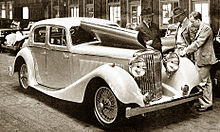Jaguar is the luxury vehicle brand of Jaguar Land Rover, a British multinational car manufacturer with its headquarters in Whitley, Coventry, England. Jaguar Cars was the company that was responsible for the production of Jaguar cars until its operations were fully merged with those of Land Rover to form Jaguar Land Rover on 1 January 2013.
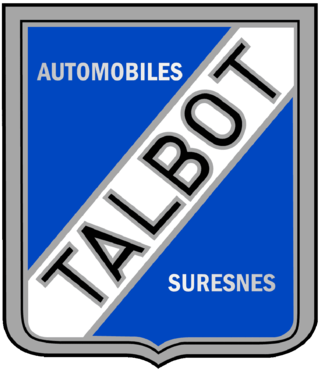
Talbot-Lago was a French automobile manufacturer based in Suresnes, Hauts de Seine, outside Paris. The company was owned and managed by Antonio Lago, an Italian engineer that acquired rights to the Talbot brand name after the demise of Darracq London's subsidiary Automobiles Talbot France in 1936.

The Jaguar XK is an inline 6-cylinder dual overhead camshaft (DOHC) engine produced by Jaguar Cars between 1949 and 1992. Introduced as a 3.4-litre, it earned fame on both the road and track, being produced in five displacements between 2.4 and 4.2-litres for Jaguar passenger cars, with other sizes being made by Jaguar and privateers for racing. A de-rated version was also used in certain military vehicles built by Alvis and Daimler.

Brough Superior motorcycles, sidecars, and motor cars were made by George Brough in his Brough Superior works on Haydn Road in Nottingham, England, from 1919 to 1940. The motorcycles were dubbed the "Rolls-Royce of Motorcycles" by H. D. Teague of The Motor Cycle newspaper. Approximately 3048 motorcycles were made in the 21 years of production; around a third of that production still exists. T. E. Lawrence owned eight of these motorcycles and died from injuries sustained when he crashed number seven; the eighth was on order. Moving forward to 2008, vintage motorcycle enthusiast Mark Upham acquired the rights to the Brough Superior name. In 2013 he met motorcycle designer Thierry Henriette and asked him to design a new Brough Superior motorcycle. Three months later a prototype of a new SS100 was shown in Milan.
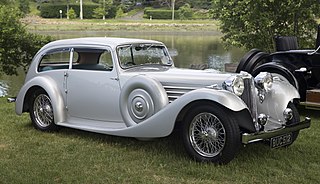
The SS 1 is a British two-door sports saloon and tourer built by Swallow Coachbuilding Company in Foleshill, Coventry, England. It was first presented to the public at the 1931 London Motor Show. In slightly modified form, it went on to be manufactured between 1932 and 1936, during which time 148 cars were built.
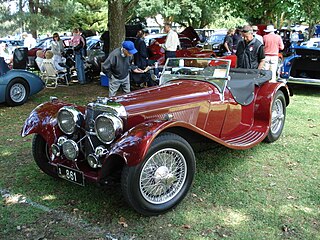
The SS Jaguar 100 is a British 2-seat sports car built between 1936 and 1939 by SS Cars Ltd of Coventry, England. The manufacturer's name 'SS Cars' used from 1934 maintained a link to the previous owner, Swallow Sidecar, founded in 1922 by Walmsley and Lyons to build motorcycle sidecars. In March 1945 the S. S. Cars shareholders agreed to change the name to Jaguar Cars Limited.
The Lanchester Motor Company Limited was a British car manufacturer in active trade between 1899 and 1955. Though the Lanchester Motor Company Limited is still registered as an active company and accounts are filed each year, the marque has been dormant since. As of 2014 it is marked as "non-trading".

Sir William Lyons, known as "Mr. Jaguar", was with fellow motorcycle enthusiast William Walmsley, the co-founder in 1922 of the Swallow Sidecar Company, which became Jaguar Cars Limited after the Second World War.

The Austin 7 is an economy car that was produced from 1923 until 1939 in the United Kingdom by Austin. It was nicknamed the "Baby Austin" and was at that time one of the most popular cars produced for the British market and sold well abroad. Its effect on the British market was similar to that of the Model T Ford in the US, replacing most other British economy cars and cyclecars of the early 1920s. It was also licensed and copied by companies all over the world. The first BMW car, the BMW Dixi, was a licensed Austin 7. In France they were made and sold as Rosengarts, and in the United States they were built by the American Austin Car Company. In Japan, Nissan also used the 7 design as the basis for their first cars, although not under licence. This eventually led to a 1952 agreement for Nissan to build and sell Austins in Japan under the Austin name.
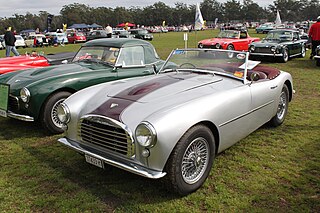
The Swallow Doretti is a two-seater British sports car built on Swallow's own design of box-section tube chassis using Triumph TR2 mechanicals, made between 1954 and 1955. It was intended for the U.S. market and to be a more refined two-seater than available there at that time.

Swallow Sidecar Company, Swallow Sidecar and Coachbuilding Company, and Swallow Coachbuilding Company were trading names used by Walmsley & Lyons, partners and joint owners of a British manufacturer of motorcycle sidecars and automobile bodies in Blackpool, Lancashire, before incorporating a company in 1930 to own their business, which they named Swallow Coachbuilding Company Limited.
Weslake & Co also known as Weslake Research and Development was founded by Harry Weslake, described as England's greatest expert on cylinder head design, with premises in Rye, East Sussex, England. Weslake is most famous for its work with Bentley, Austin, Jaguar and the Gulf-Wyer Ford GT40 Mk.I.
William Walmsley was with William Lyons a co-founder of the Swallow Sidecar Company, which later became the Jaguar car company.
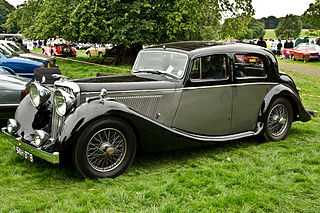
The Jaguar Mark IV is a range of automobiles built by Jaguar Cars from 1945 to 1949. The cars were marketed as the Jaguar 1½ litre, Jaguar 2½ litre and Jaguar 3½ litre with the Mark IV name later applied in retrospect to separate this model from the succeeding Mark V range.

The Triumph Roadster is a roadster produced by Britain's Standard Motor Company from 1946 until 1949. It was first available as the Triumph 1800 Roadster (18TR) from 1946 to 1948 and then as the Triumph 2000 Roadster (TRA) from 1948 to 1949.

The MG SA or MG 2-litre is a sporting saloon that was produced by MG from 1936 to 1939. Launched as the 2-litre, it only later became known as the SA, the car had been originally planned as an advanced performance saloon to rival the likes of SS Cars and even Bentley with all independent suspension and was given the factory code of EX150 and designated the S-type. A prototype was made but with the amalgamation of MG with Morris Motors in 1935, development stopped. The Cowley drawing office picked up the project again but a much more conservative car appeared with conventional live rear and beam front axles.
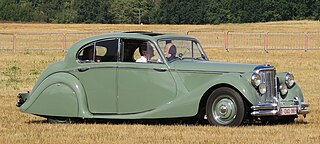
The Jaguar Mark V is a luxury automobile built by Jaguar Cars Ltd of Coventry in England from 1948 to 1951. It was available as a four-door Saloon (sedan) and a two-door convertible known as the Drop Head Coupé, both versions seating five adults. It was the first Jaguar with independent front suspension, first with hydraulic brakes, first with spats, first specifically designed to be produced in both Right and Left Hand Drive configurations, first with disc centre wheels, first with smaller wider 16" balloon tyres, first to be offered with sealed headlamps and flashing turn signals for the important American market, and the last model to use the pushrod engines.

The Wolseley Hornet is a six-cylinder twelve fiscal horsepower lightweight automobile which was offered as a saloon car, coupé and open two-seater as well as the usual rolling chassis for bespoke coachwork. Produced by Wolseley Motors Limited from 1930 until 1936, the Hornet was unveiled to the public at the end of April 1930. Wolseley had been bought from the receivers by William Morris in 1927.

William 'Bill' Munger Heynes CBE, born in Leamington Spa, was an English automotive engineer.

The Standard Flying Fourteen is an automobile produced by the British Standard Motor Company from 1936 to 1940 and announced in October 1936. The other Flying Standard models had been announced twelve months earlier. A standard is a flag and the reference to flying standards is to flying flags as well as to the advertised abilities of the cars.











